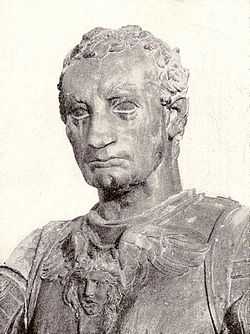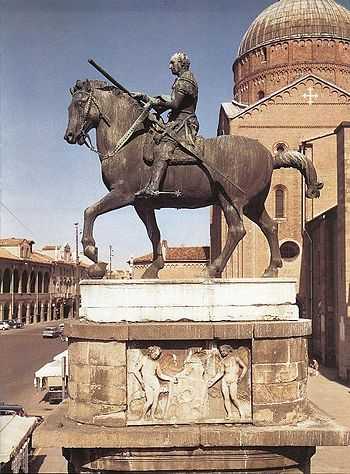Erasmo of Narni
This article is about the condottieri Erasmo da Narni. For Donatello's equestrian statue, see Gattamelata (Donatello)


Erasmo of Narni (1370 – January 16, 1443), better known as "Gattamelata" (meaning "The Sweet Cat"), was among the most famous of the condottieri or mercenaries during the Italian Renaissance. He was born in Narni, and served a number of Italian city-states: he began with Braccio da Montone, served Pope and Florence equally, and served Venice in 1434 in the battles with the Visconti of Milan.
He was the subject of Donatello's equestrian bronze sculpture in the main square of Padua, the same city over which he became podestà in 1437.
In Narni, the farmhouse in which Gattamelata was born bears a plaque reading "Narnia me genuit Gattamelata fui — (I was born in Narni, I was Gattamelata)."[1]
Sources
- Giovanna Baldissin Molli, Erasmo da Narni, Gattamelata, e Donatello: storia di una statua equestre; con l'edizione dell'inventario dei beni di Giovanni Antonio Gattamelata (1467) a cura di Giulia Foladore, Padova 2011
- Joachim Poeschke, Reiterbilder und Wertesymbolik in der Frührenaissance – Zum Gattamelata-Monument Donatellos, in: Joachim Poeschke, Thomas Weigel, Britta Kusch-Arnhold (Hgg.), Praemium Virtutis III – Reiterstandbilder von der Antike bis zum Klassizismus. Rhema-Verlag, Münster 2008, ISBN 978-3-930454-59-4
- Raphael Beuing: Reiterbilder der Frührenaissance – Monument und Memoria. Rhema-Verlag, Münster 2010, ISBN 978-3-930454-88-4
- Antonio Menniti Ippolito, Erasmo da Narni (Gattamelata), in Dizionario Biografico degli Italiani, XLIII, Roma 1993, pp. 46–52.
External links
- ↑ From the guide of the Comune di Narni.
- Photos of the statue of Gattamelata
- Narni Town - information about Erasmo da Narni
- Equestrian Statues of the Renaissance
Authority control